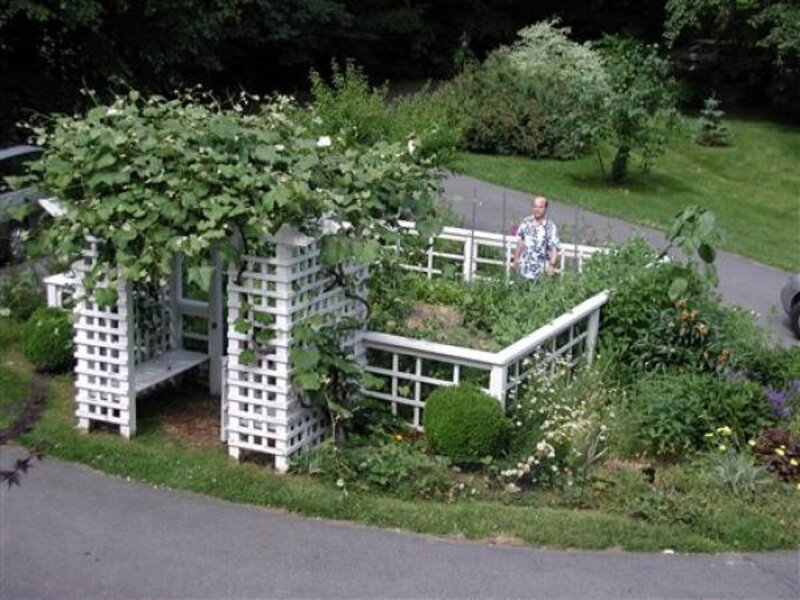10 steps to success with your first vegetable garden
Loading...
How about going to a place where you can relax, enjoy some sun, and get a little exercise and gourmet food? A place even your kids could find interesting? This "spa" need not cost much; in fact, it will save you money.
It's a home vegetable garden, and don't be intimidated if you've never planted one before. Vegetables are easy to grow, especially if you follow these 10 steps for first-timers:
1. Choose a location in full sun, which means six or more hours of direct sun in summer. Producing succulent, savory vegetables takes energy – the sun's energy – especially for fruiting vegetables such as cucumbers and tomatoes. If you don't have this much sunlight, either get out your pruning saw or grow only leafy vegetables such as lettuce and spinach.
2. Your site needs soil that is well-drained. Roots have to breathe, which they cannot do if water sits in or on the soil for too long after rains. If grass or most weeds grow well, the soil is probably well drained. To be more quantitative, dig a hole, fill it with water, and measure with a ruler how fast the level drops. Slower than 1 inch per hour is too slow. Choose another site or build raised beds.
3. Grow your garden as close as possible to your door — no farther than your wife can throw the kitchen sink, goes the old adage, said when kitchen sinks were cast iron. The closer to your door, preferably your kitchen door, the more frequently you'll enjoy and work in the garden.
4. Start small. Too much garden may begin to feel like work. You can raise plenty of vegetables in even a 10-by-10-foot plot of land. Increase the size of your garden commensurate with your enthusiasm and experience.
5. Fence your garden. A fence, besides keeping out rabbits and other hungry animals, helps define your garden visually. Poultry netting is inexpensive and effective. To keep animals from burrowing under your fence, bend the bottom foot of fencing to the outside of the garden to lay right on top of the ground. Unless deer are a threat – in which case you need a fence 5 or more feet high – a 2- or 3-foot-high fence should be adequate.
6. Make your garden pretty. Yes, it's a vegetable garden, but even vegetable gardens can be pretty. Wooden pickets can obscure and dress up a poultry netting fence. An arbor, with climbing beans or grapes, can dress up your garden gate. Soften the fence line with an outside border planting of shrubs, perhaps something decorative and edible such as red currants or blueberries. Beauty will also draw you into your garden.
7. Planning your garden in four dimensions is a way to harvest more from limited space. Rather than single, widely spaced rows, plant in wide (3 to 4 feet) beds (a second dimension). Rather than keeping everything at ground level, let your vegetables – those that can – grow up (a third dimension). Pole beans and tomatoes can be trained up bamboo or metal poles, and peas and cucumbers can be trained up fences – even that fence that encloses your garden. For the fourth dimension – time – use transplants for tomatoes, peppers, eggplants, and cucumbers, and plant shorter-season vegetables to follow those that finish early or start late, such as lettuce following early bush beans.
8. Pay attention to fertilizing and watering. Spread a balanced organic fertilizer over the ground in late winter at the rate suggested on the container. Or, if existing vegetation is growing well, use soybean meal at 2 pounds per 100 square feet. Or apply an inch depth of compost. Set out a straight-sided can to measure water, and turn on the sprinkler once a week so the combination of rain and sprinkling equal an inch depth of water in that can.
9. Weed regularly and frequently. Weeds are much easier to kill — and haven't had time to spread many seeds — when they are small.
10. Grow vegetables that you like to eat, and choose the best-tasting varieties.
So get a tiller or shovel, and dig up your new garden area, or use the newer method of smothering existing vegetation beneath a few layers of newspaper topped with compost or other mulch, then plant immediately.
For future successes, thoroughly clean up old plants when they're finished or at the end of the season, and move plants around the garden so they don't grow in the same spot for a couple of years.
Finally, read about gardening. I suggest "Vegetable Gardening: From Planting to Picking – The Complete Guide to Creating a Bountiful Garden," by Fern Marshall Bradley and Jane Courtier; "The Vegetable Gardener's Bible," by Edward C. Smith; and my own "Weedless Gardening."
-----
Follow us on Twitter and Facebook.
Check out the Monitor’s main gardening page, which offers articles on many garden topics. Access all our blog posts here (keep scrolling down to read more), If you don't want to miss any of our gardening coverage, consider subscribing to the RSS feed of the gardening page and the RSS feed of Diggin' It. Do visit Gardening With the Monitor on Flickr. Take part in the discussions and get answers to your gardening questions. If you join the group (it’s free), you can upload your garden photos and enter our next contest.





